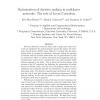Free Online Productivity Tools
i2Speak
i2Symbol
i2OCR
iTex2Img
iWeb2Print
iWeb2Shot
i2Type
iPdf2Split
iPdf2Merge
i2Bopomofo
i2Arabic
i2Style
i2Image
i2PDF
iLatex2Rtf
Sci2ools
NECO
2008
2008
Optimization of Decision Making in Multilayer Networks: The Role of Locus Coeruleus
Previous theoretical work has shown that a single layer neural network can implement the optimal decision process for simple, two alternative forced choice (2AFC) tasks. However, it is likely that the mammalian brain is comprised of multilayer networks, raising the question of whether and how optimal performance can be approximated in such an architecture. Here, we present theoretical work suggesting that the noradrenergic nucleus locus coeruleus (LC) may help optimize 2AFC decision making in the brain. This is based on the observations that neurons of the LC selectively fire following the presentation of salient stimuli in decision tasks, and that the corresponding release of norepinephrine can transiently increase the responsivity, or gain, of cortical processing units. We describe computational simulations that investigate the role of such gain changes in optimizing performance of 2AFC decision making. In the tasks we model, no prior cueing or knowledge of stimulus onset time is as...
| Added | 14 Dec 2010 |
| Updated | 14 Dec 2010 |
| Type | Journal |
| Year | 2008 |
| Where | NECO |
| Authors | Eric Shea-Brown, Mark S. Gilzenrat, Jonathan D. Cohen |
Comments (0)

